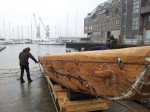 The hand-crafted replica of a 4000-year-old sewn-plank boat was successfully launched into the waters of Falmouth Harbour Wednesday. At noon, she was officially christened Morgawr, “sea monster” in Cornish, and before a crowd of onlookers, she was guided into the bay.
The hand-crafted replica of a 4000-year-old sewn-plank boat was successfully launched into the waters of Falmouth Harbour Wednesday. At noon, she was officially christened Morgawr, “sea monster” in Cornish, and before a crowd of onlookers, she was guided into the bay.
 Carrying a crew of 18 paddlers plus a coxswain, the oak plank boat put together with yew twigs, moss, tallow and beeswax, managed to not sink during two 500-meter (1640 feet) trial runs. The team who spent 11 months building the boat is in seventh heaven.
Carrying a crew of 18 paddlers plus a coxswain, the oak plank boat put together with yew twigs, moss, tallow and beeswax, managed to not sink during two 500-meter (1640 feet) trial runs. The team who spent 11 months building the boat is in seventh heaven.
“I’m so happy with the responsiveness of the boat. We always said you had to build the whole boat to understand what Bronze Age people experienced,” said the project’s leader, University of Exeter archaeologist, Professor Robert Van de Noort, who is working together with the National Maritime Museum Cornwall.
“When I was steering the boat and it got up to speed, I could turn her easily and it was more seaworthy than I expected. We have learnt so much through the whole process and today’s launch has revolutionised everything we knew,” said the professor.
“There have been doubters, professionally, who questioned the feasibility of this vessel crossing the seas. This morning’s experiment strongly suggests that it was capable of doing so,” he said.
 As long as the crew could paddle and bail vigorously, that is. There’s video of the launch on the BBC website and there was a not inconsiderable amount of water sloshing around in the bottom of that boat. University of Exeter experimental archaeologist Dr. Linda Hurcombe tells the reporter that some water accumulation is to be expected when a boat is first put to sea.
As long as the crew could paddle and bail vigorously, that is. There’s video of the launch on the BBC website and there was a not inconsiderable amount of water sloshing around in the bottom of that boat. University of Exeter experimental archaeologist Dr. Linda Hurcombe tells the reporter that some water accumulation is to be expected when a boat is first put to sea.
I don’t know enough about boating to confirm or deny that contention, but the frantic bailing you see in the beginning of the video doesn’t continue when the rowing begins. There’s still a few inches of water in the bottom of the boat, though, and they didn’t record the entire trial run so who knows how much more of it they had to do. Keeping any cargo the Bronze Age boaters would have been transporting dry would certainly have been a challenge.
There will be further trial runs to assess how Morgawr takes on water. Once they’re done, the boat will go on permanent display at the National Maritime Museum Cornwall in Falmouth.